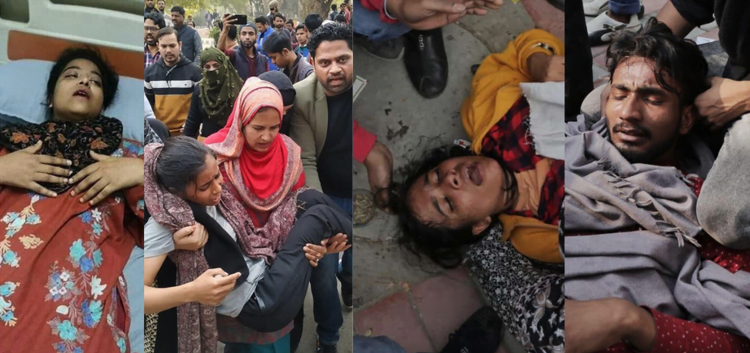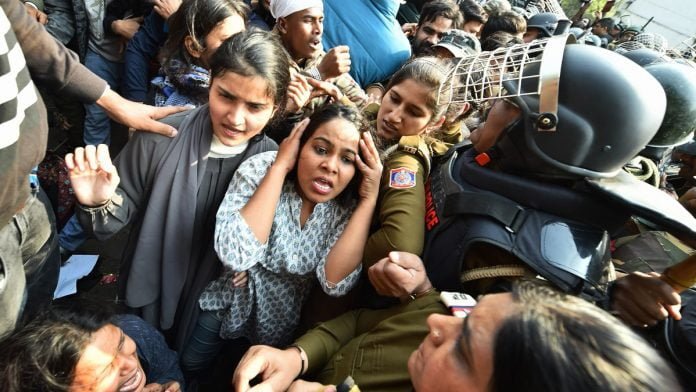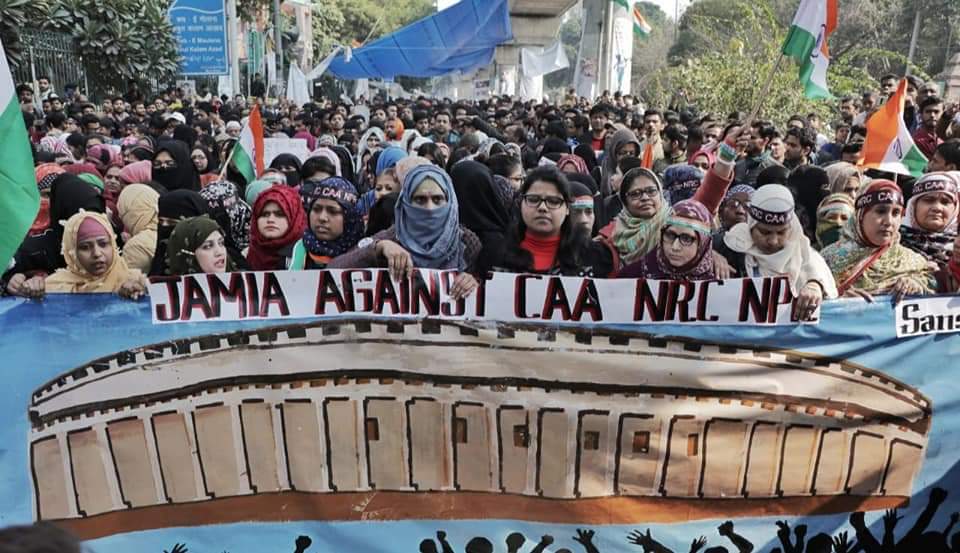Trigger Warning: Violence, Police Brutality
Iman, 18 years old, proudly went from department to department with a tambourine urging students to join the anti-CAA march in large numbers. But her thoughts changed drastically by the evening. Today, she is on bed rest with tears and blood flowing from her eyes. The nurse gives her sleeping pills but to no avail, as she would constantly shouts in her sleep, “I can hear the boots“, “Somebody is pulling me.” When she gains consciousness she recalls the harrowing experience.

On 10th February 2020, students at Jamia Millia Islamia gave a call for protest march to the Parliament. This was their fourth call against the Citizenship Amendment Act or CAA, the NRC and the NPR. All the previous marches were failed attempts which ultimately led to state sponsored police brutality. The march on 10th February met the same end but many of the stories were lost in the dilemma of ‘to conceal’ or ‘not to conceal’. The protest had a large number of women on the front which included both the students and locals of Jamia Nagar. This group was stopped at the Holy Family Hospital. When a woman leads a march, she goes with her courage along with her vulnerability to violence. This time it was not the courage that was absolved but the physical and emotional vulnerability that was bruised.
“Every other time the police used the lathi and tear gas out in the open, but this time they changed their strategy so that they won’t get in the mainstream media. They didn’t swing their lathis in the air to hit us but used it cleverly to hit us on our toes,” says Iman.
“Every other time the police used the lathi and tear gas out in the open, but this time they changed their strategy so that they won’t get in the mainstream media. They didn’t swing their lathis in the air to hit us but used it cleverly to hit us on our toes,” says Iman. She with her group of women tried to cross the barricade but a group of male constables held her tight to suffocate her, touching inappropriately while the female constables kept pinching all over her body.
The male police officers kicked in her stomach. She kept vomiting while asking them to stop but the female cops told her, “Tum gumraah ho gaee ho, marne aayee ho to mar jao” (You have gone astray. You have come to die so be dead). Today, she is completely traumatised. Her mother stands besides her trying to keep a check on her statements to the media and trying to balance the fine line between modesty and shame. “This is what the police wanted, they wanted to hit them in a way that they are ashamed to talk about it,” she said. Today Iman keeps shifting from one hospital to another without any relief. But the hopes of these women are still alive and they are ready to go for a counter strategy for the CAA protests.

Chanda Yada, student at Jamia Millia Islamia said, “While I tried to cross the barricade, the police tried to suffocate me and lift my clothes up.” Chanda was hit in the stomach and later detained in a bus. There was not a single woman in the bus. The male police slapped Chanda on her face and asked her for her ID proofs. They took note of her address and threatened her that they would tell her family about her and may be her parents would keep a check on her.

The locals often make a good number in these CAA protests. Women from all age groups come in solidarity with the students; their slogans no less than the students. Aafreen, a local resident of Jamia Nagar sat on the pavement of Maulana Mohammad Ali Jauhar Marg. In a breathless voice, she showed me her hands with scratches all over. She said, “See, the female constable has pinched me all over. What crime did I commit?” Fauzia, a hijabi woman lost her hijab in the interface with the police. She said, “Our Hijabs were deliberately pulled off, many of us have lost our hijabs and shoes in the stampede.” Many women got their hijabs and hair pulled while other were heckled by their clothes. The clothes are the Hijabs of some.
She said, “See, the female constable has pinched me all over. What crime did I commit?” Fauzia, a hijabi woman lost her hijab in the interface with the police. She said, “Our Hijabs were deliberately pulled off, many of us have lost our hijabs and shoes in the stampede”. Many women got their hijabs and hair pulled while other were heckled by their clothes. The clothes are the Hijabs of some.
Rafia Fatima, a mother of three children is very passionate about the anti CAA protests. She has actively participated in all the protests. To give her time to the anti CAA movement, she has hired a domestic worker at home for her kids. Rafia observes the traditional purdah, her veil pulled tightly over her face. However, that day, her veil was ripped off her face. Rafia recalls while lying in the emergency ward of the hospital, “The police tried to strangle me, they held me upside down, kicked me in the stomach and hit me on my knees and between the legs.” She adds “One of the policemen got over my chest with his boots on.” The hospital reports later revealed that Rafia has a hairline fracture in the ribs.
Zainab F. while walking towards Sukhdev Vihar was stalked by two young men in the presence of heavy police who kept hurling abuses at her and shouting, “**** you live in India, eat from this place and you seek freedom from this place.” She said, “If they want to attack us on our morality and want us to sit at home out of shame, then that is not going to happen, we will come back, with more vigour.” Her weak voice trembles as she says, “The pain might vanish but my body is never going to forget its encounters...” and she breaks down.
One of the protesters who received several injuries said, “My body aches, my doctors advised crepe bandage but I cannot put them at home”. She told that she cannot even openly cry or tell where it hurts her as her family is very reluctant to send her to protests.
‘Kashmir se bhi bura haal karenge‘ (We will make it worse than Kashmir) threatened one of the police men to the protesters. The threat of of making Jamia Nagar, a Muslim ghetto worse than Kashmir is in itself a loaded term, a metaphor. The threat was not given in the heat of the moment but comes out of years of hateful learning. The irony of our system is we may move on to a common civil code while a common criminal code will hang between the lines of Tagore,
“Into that heaven of freedom, my Father, let my country awake.”
Also read: Beyond Generation Gap: What Do Parents Think Of Anti CAA Protests?
55 years old Mrs Mojibi, mother of Rafia Fatima said, “My daughter has been hit in her ‘private parts’. If they are not ashamed to do it then why should we be ashamed to talk about it.” But not every mother and daughter share the same equation as Rafia and her mother. Many parents want their children to passively participate in the CAA protests but don’t want active confrontations. One of the protesters (on condition of anonymity) who received several injuries said, “My body aches, my doctors advised crepe bandage but I cannot put them at home.” She said that she cannot even openly cry or tell where it hurts her as her family is very reluctant to send her to protests. Perhaps if they come to know, her mobility will get restricted.
The body has its pain, the mind has its own interface but if we talk specifically into the dynamics through the lens of gender, we should realise that the repercussions are far greater. A mother already declared taking the agency of choice on behalf of her daughter, “I would prefer a distant mode of education for her rather than regular classes if she continues with all this.” The government may keep churning lucrative schemes for girls which might take up spaces on humble autos and the common man’s bus but have they really made a safe space for common woman’s daughter is the real question.
Also read: Women’s Agency In Shaheen Bagh And In Other Protests Against CAA
Shahjahan, 60 years old local comes to all the CAA protests. When asked what derives her to come to these protests she said, “I come for these children, they are fighting for our rights, If they want to kill us then I am ready to die.”
Featured Image Source: The New Indian Express




